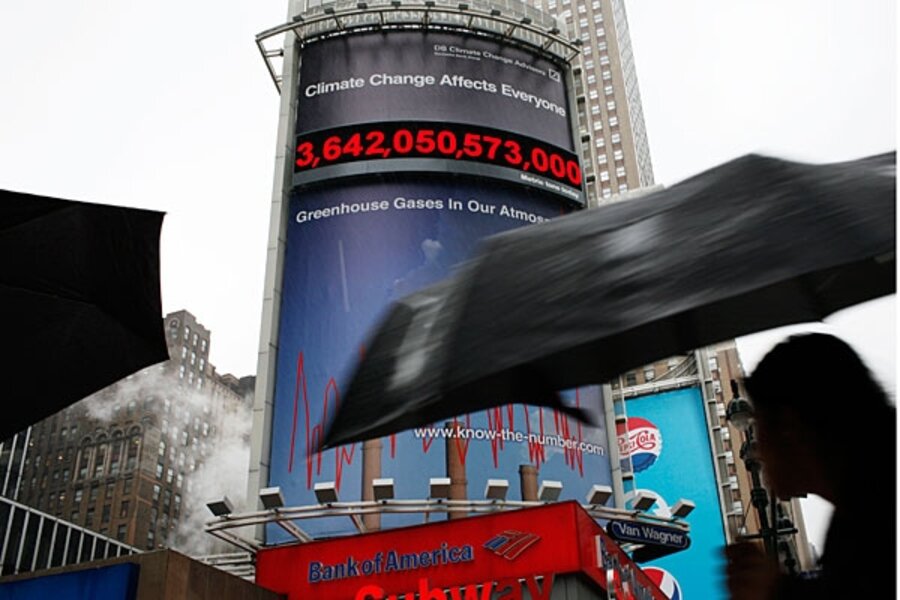Giant Madison Square climate counter helps make the invisible visible
Loading...
You know the National Debt Clock? That's the sign on New York's Sixth Avenue that keeps track of the amount of money the US federal government owes. Let's just say it's a big number.
Now someone has done the same thing with greenhouse gasses. At a drizzly ceremony in Madison Square Garden Thursday, the global investment firm Deutsche Bank flipped the switch on their Carbon Counter, 70-foot-high billboard that keeps a real-time count of how many metric tons of the greenhouse gases we're spewing into our atmosphere. According to the counter (which Deutsche Bank says is carbon neutral) we're up to 3.64 trillion metric tons.
And counting. According to a press release from Deutsche Bank Climate Change Advisors, the we emit 2 billion metric tons per month, or about 800 metric tons per second. The last two digits on the counter are a blur.
Despite the name, the Carbon Counter counts more than just carbon dioxide, the greenhouse gas that gets all the headlines. It also includes other heat-trappers like methane, ozone, nitrous oxide, and chlorofluorocarbons. Trying to calculate the varying effects of all these gases and converting them to a single unit is a real chore, which is why the Deutsche Bank enlisted some big brains at MIT to crunch the numbers.
Newsweek's Michael D. Lemonick explains how they arrived at the final rate.
For one thing, each of these gases traps heat at a different rate (OK, they really trap infrared radiation, but it ends up amounting to the same thing). Methane, for example, is a much more efficient energy-trapper than CO2; it's just that we emit a lot less of it. Each of these gases, moreover, degrades in the atmosphere at a different speed. That means you can't just add them up. "It's like you give someone a hundred dollars," says MIT atmospheric scientist Ron Prinn, "but it's a mix of Australian and Canadian and U.S. dollars. You have to make some conversions before you know what it's worth." For the Carbon Counter, those conversions run into many pages of equations, at the end of which you get a number representing the "CO2 equivalent" of 20 different gases. Add them up, and you're at 2 billion tons daily.
Last year, The New York Times's Dot Earth blogger Andrew Revkin speculated how humans' response to global warming would be different if carbon dioxide were pink instead of colorless. He wrote:
The point, of course, is that unlike the pollution issues that characterized the 20th century, human-propelled climate change is not “in your face.” All of the potential harms are spread over time and geography and mainly ... will play out as a shift in odds rather than a direct noxious or visible impact.
As the Deutsche Bank press release explains, the purpose of their counter is to attempt to make invisible greenhouse gases visible.
[S]ince we can't see them, it's easy to forget they are there. Out of sight, out of mind. And if we aren't aware of these "carbon" gases, it's easy to ignore the urgent need to reduce their emission.
But will it work? Treehugger's Jaymi Heimbuch is concerned that the sign will "become background noise in about a week, like every other billboard." She also worries about the usefulness of displaying a big number without any context.
When a number gets this huge, Ms. Heimbuch writes, "people need something to compare it to, some way to visualize it so that we get its meaning."
Perhaps this is why the National Debt Clock didn't seem to do much to curb federal borrowing. Last September, the clock came to a sudden halt as the US debt topped $10 trillion. The counter had run out of numbers.





